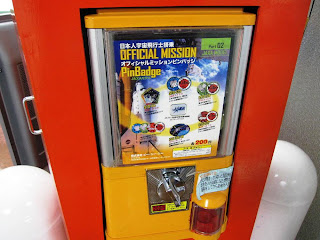As I said many times before, my city has a lots of Institutes. All of them specialize in very cutting-edge experiments and stuff, but I would name this JAXA as the most state-of-the-art Institute. You can enter the premises free of charge and take a look around.
I showed the H-II rocket that was standing upright in Tsukuba Expo Center in December, but this one was more intricately made. Our researchers spent about 10 years to complete this rocket, and the technology of this rocket is the foundation of the huge rockets that Japan has been developing.
The rear-end of the H-II rocket. Just by looking at this picture, you might not notice how impressive this is, but as I usually don't have a chance to take a close look at any rocket, this one seemed so enormous to me.
I had to register at the reception to take a look around, and this souvenir shop was just next to it. These caps looked cool, but I thought only people who work for this Institute would be proud of having one.
Space shuttle model kits. If I had a kid I would buy him one. Japan doesn't have the ability to launch a space shuttle as you know, but we have rockets that put satellites into orbit.
Teddy Bear astronauts. 2656 yen is about 28 us dollars. Little girls would be pleased to have one. I've heard that Teddy bear is from the USA, where they've launched space shuttles. So when we are successful in launching one they should sell a "Samurai" astronaut or something as a souvenir.
Spaceman pens. It would be fun to put one on your desk, but would you think they are easy to use?
Official Mission Pinbadge. You can see three kinds of Kibo badges, and Kibo is the Japanese experiment module that is docked to ISS (International Space Station).
This satellite is called Kaguya or SELENE (SELenological and ENgineering Explorer). In a Japanese folktale "Taketori Monogatari", a girl named Kaguya appears. She eventually returns to the moon, and this must be the reason why this lunar satellite has the same name.
From left to right: N-I, N-II, H-I, H-II, H-IIA and H-IIB rocket. The USA and Japan collaborated to develop the N-I rocket, which put into orbit the first Japanese fixed satellite named ETS-II. And since H-II, Japan started to develop its own rocket.
Most of the scientific research is beyond my understanding, but somehow I'm interested in space. And as I live in a rural area, I can see lots of stars in the sky in the night =)








